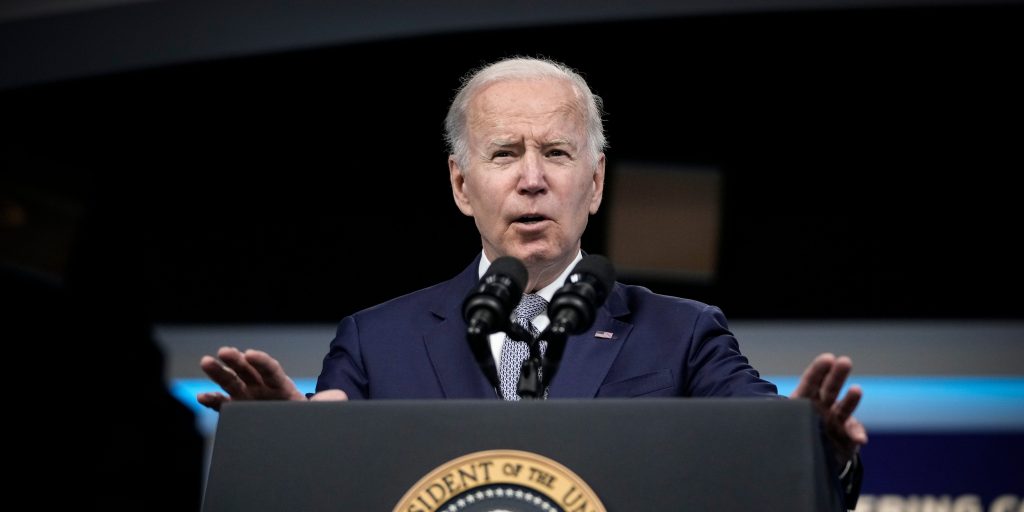- The details of Biden's student-debt relief announcement reveal other ways the White House is helping borrowers.
- The administration overhauled income-driven repayment plans and offered more aid to Pell Grant recipients.
- The debt forgiveness plan is also tax-free at the federal level, saving borrowers from a hefty tax bill.
The headline figures from President Joe Biden's student-debt forgiveness plan are simple enough, but several key details reveal other ways the administration is helping borrowers.
The president announced Wednesday that borrowers earning less than $125,000 will have $10,000 in student debt canceled. The administration also extended the deadline for student loan repayment one last time to December 31 from August 31, giving borrowers four more months to prepare for the payment freeze to end.
Yet the White House's announcement included several smaller details that reveal a more sweeping plan to support those saddled with student debt. From more generous relief for Pell Grant recipients to a revamped income-based repayment program, here are the additional parts of Biden's student-loan plan.
Pell Grant recipients get twice the relief
Biden's plan is even more generous for Pell Grant recipients. The Department of Education is poised to forgive up to $20,000 in loans for such borrowers, doubling the relief for Americans on the lower end of the income spectrum.
The $20,000 in aid is solely for forgiving loans, meaning any remainder after cancelation won't be sent as a direct payment. For example, a Pell Grant recipient with $15,000 in debt will have their entire balance forgiven, but won't receive any additional support afterward.
"The Pell Grant program is one of America's most effective financial aid programs—but its value has been eroded over time. Pell Grant recipients are more than 60% of the borrower population," a White House fact sheet said. "The Department of Education estimates that roughly 27 million borrowers will be eligible to receive up to $20,000 in relief, helping these borrowers meet their economic potential and avoid economic harm from the COVID-19 pandemic."
The same eligibility rules apply to Pell Grant recipients. Borrowers earning more than $125,000 won't see any of their debt canceled. Couples filing jointly and earning more than $250,000 are also ineligible for debt forgiveness.
Debt relief won't come with a hefty tax bill
While the IRS usually counts most forms of debt forgiveness as taxable income, Biden's student debt relief will be regarded as untaxable income at the federal level. That means eligible borrowers won't have pay back much of the relief in the form of a higher tax bill come April. The tax-free nature of the program relies on Biden's stimulus package from last year, which made student debt cancelation debt-free through 2025.
That's not to say all eligible borrowers are safe from higher state taxes. While some states' tax codes for income resemble federal laws, others have their own rules for forgiven debt. That could leave borrowers with a larger tax bill as some of their forgiven debt is deemed taxable income in their state.
Millions of borrowers could have loans forgiven automatically
For millions of Americans, the loan support might not even require an application. Nearly 8 million borrowers may be eligible for automatic relief because the Education Department already has access to relevant income data, the administration said.
For the remaining eligible borrowers, the White House said it will launch a "simple application" in the coming weeks. The announcement guaranteed the application will be available before student loan repayment resumes on January 1, 2023.
Income-based repayment 2.0
The administration also overhauled income-based repayment plans, offering a more flexible program for borrowers looking to pay down their debt over a longer period of time.
For one, borrowers will no longer have to pay more than 5% of their monthly discretionary income on undergraduate loans. That's half the share of income set in current income-driven repayment (IDR) plans and could save borrowers hundreds of dollars every month as they pay down their debt.
The non-discretionary income threshold for IDR plans was also slashed. The Department of Education will now guarantee that borrowers earning less than 225% of the federal poverty level won't have to make any monthly payment. That currently equates to incomes of roughly $31,000, or a wage of $15 an hour.
The White House halved the amount of time it takes for loan balances to be forgiven for some IDR borrowers. The government will now cancel debt balances after 10 years of payments for those with less than $12,000 in loans. That's down from the previous 20 year threshold.
Lastly, the Education Department will cover IDR borrowers' unpaid monthly interest moving forward, meaning borrowers on IDR plans won't see their loan balances grow so long as they make their monthly payments. The department recently announced plans to prevent interest from spiraling within its regulatory proposals, which will likely be implemented July 2023.
